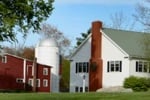DORCHESTER HEIGHTS NATIONAL HISTORIC SITE
DORCHESTER HEIGHTS NATIONAL HISTORIC SITE
The seizure and fortification of Dorchester Heights in March 1776 was the first real stroke of military success enjoyed by the Continental Army in the War for Independence. Not only were the British forced to evacuate Boston by Gen. George Washington's unexpected move, but this success served also to inspire hope and confidence in the leadership and capabilities of the Continental Army.
This masterful operation was launched from Dorchester and Roxbury, and was very carefully planned, utilizing about 2,400 troops and militia with a continual procession of carts and wagons, screened partially by bales of hay, carrying long bundles of birch saplings (intended for facines for building up breastworks on exposed ledges and on frozen ground) and other materials. The labor began on the night of March 4, under a bright moon. It proceeded so rapidly that by daylight the forts on the two highest hilltops of what is properly Dorchester Heights were well enough advanced to offer some defense against assault. When Gen. William Howe looked on the redoubts from his bedchamber that morning, he is said to have remarked, "The rebels have done more in one night than my whole army would have done in a month."
Colonel Henry Knox had brought overland from Fort Ticonderoga 70 artillery pieces which, promptly placed on Dorchester Heights, rendered the city untenable by the British and threatened also the vessels in the harbor. Howe determined to attack immediately, and the Americans waited resolutely "in a position twice as strong as Bunker Hill, with a force more than twice as large, and under the immediate eye of the General-in-Chief." They were snug in their works, with rows of stone- and sand-filled barrels ready to roll down upon any attacking force. The intended attack never came. The British artillerists found that they could not elevate their guns sufficiently to reach the American parapets, and a boisterous storm prevented the movement of troops needed for a planned night attack. Washington worked all the while to perfect the fortifications, and soon made them, as far as Howe's army was concerned, impregnable. The British evacuated on March 17?an army of 11,000 men, with 1,100 loyalist refugees, in their transports.
Every side of the heights is now built up, but the white marble monument at the summit looks sufficiently high even today to reveal a position that was naturally strategic and, with fortifications, very formidable. The monument is 115 feet high, consisting of a tower and steeple reminiscent of a New England meeting house of 200 years ago. It was dedicated on March 17, 1902, the 126th anniversary of the British evacuation of Boston.
Under the terms of a cooperative agreement signed by the Secretary of the Interior and the Mayor of Boston on March 17, 1951, Dorchester Heights was designated a National Historic Site. At the time, the monument and Thomas Park, named for Gen. John Thomas who commanded the troops on Dorchester Heights, were under the jurisdiction of the Department of Parks, City of Boston. In 1966 the Heritage Conservation and Recreation Service added Dorchester Heights to the National Register of Historic Places. Twelve years later the National Parks and Recreation Act authorized the City of Boston to transfer the site to the National Park Service. At that time, it joined the eight other sites which comprise Boston National Historical Park, established in 1974.


